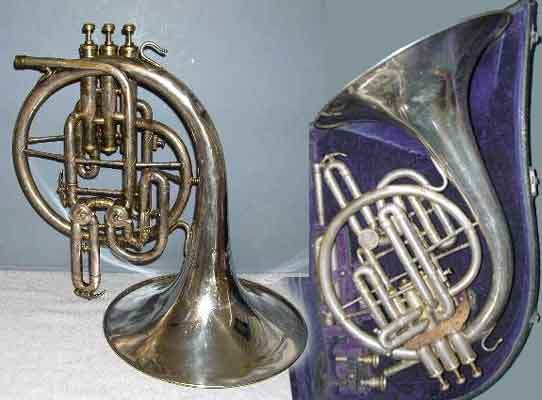Daryl Fletcher wrote:
I always thought it was a bit odd that horn players in US bands are generally expected to play one instrument in concert band and then a different instrument with a different mouthpiece, fingerings, etc., in marching band. I wonder how we ever ended up with that tradition. Both my high school and college marching bands used marching mellophones, which I guess is quite typical.
Part of the reason is the inertia of tradition. As I interpret my sources, the standard alto band instrument in the US was the alto horn right from the pre-Civil War era until sometime around WWII. The shapes have varied:
OTS
Helicon (unbelievable, but I have a such one from Boston represented in my galleries)
Top action pistons straight bell
Front action pistons bell front
The latter probably being the most widespread variant until the horns-for-concerts and mellophones-for-marching trend took over. I cannot deliver hard proof, but my sense for history and economics tell me, that this trend was an expression of the fairly fast recovery of the US economy after WWII. Even bands should be PC and use the more prestigious French horns.
Sadly these are pure hells to march for two reasons: poor balance and a fairly narrow mouthpiece rim. This combination has a very obvious inherited danger: swollen lips and even loose incisors.
I am, or at least was, a multi brass player. No problems with shifting from horn through trombones to tuba. Only the use of trumpet rims spoiled my horn embouchure totally (and that basically is, what is imposed on the poor kids hauled forth and back between horn and mellophone).
So for many years I played my trumpets, cornets, and flugelhorns through my horn mouthpiece via a bunch of adaptors, some homemade. No problems with intonation or sound, but endurance certainly was a problem when playing Eb cornet. Later on I have had a screw rim system made for various underparts fitting my horn rim (18mm aperture, which is quite large).
I play with the old style Einsetzen/inset horn embouchure. Younger players use the Ansetzen/onset embouchure, which together with the much wider rimmed horn mouthpieces available today should make it possible to play marching horns like the Yamaha Bb showed without too many hazards to the embouchure.
And then I will back the point made by Barry Tuckwell: horns played outdoors more are a visual than an aural factor. They hardly can be heard. If I marched a horn, I would fake it except for the very few places, where the horns have important parts. I have played lots of marches and i only have met two important horn solos.
The last time I marched, February 1994 through inner Copenhagen in a Lent carnival demonstration for peace, I was asked to bring my horn.
No way! So I brought my alto trombone. More comfortable for me, and certainly better heard.
Daryl Fletcher wrote:By comparison, it would seem that we have it quite simple when learning to play a tuba in a different key.
The only people, who should experience problems with shifting key of tuba, should be those with absolute pitch.
Any educated player knows, that any notation is just a relative indication of a sequence of intervals. If one has a thorough insight in our scale system, going from one pitch to another is a small problem. I don’t have a really stable perfect pitch, and have played instruments in C, B nat, Bb, A, G, F, and Eb. But I never got on friendly terms with CC tubas. I can’t find the open notes.

Daryl Fletcher wrote:Daryl, who often wonders why things are the way they are.
Traditional thinking!
Klaus Smedegaard Bjerre









